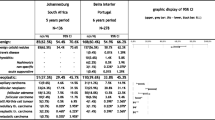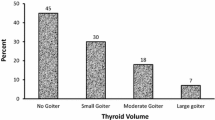Abstract
Why speak still today about endemic goiter and cretinism in the Alps? because thyroid pathology represents the discovery paradigm of endocrinology, the first explanatory and curative anatomo-clinic schema of endocrinology. Great figures, naturalists, physicians, biologists, surgeons, many of which issued from the French (Fodéré, 1792), Swiss (Kocher, Nobel prize in 1910), Austrian (Wagner-Jauregg, Nobel prize in 1927) and Italian Alps (Malacarne, 1780) contributed to these discoveries though the centuries and deserve for this reason to be honored.
The present work is a historical and iconographic review, which relates the evolution of this pathology and it's representations, from Antoquity to the present days. These representations have beeon described in several monographs, among which Merke's (1984) extraordinary “History and Iconography of Endemic Goiter and Cretinism”, but also in literary works with Balzac's “Le médecin de campagne”.
It's only in the beginning of the XX century that the inclusion of iodized salt in the diet has radically transformed the disease and its consequences. But this pathology has left painful traces in the collective imagination of Alpine people.
Finally the anxiety provoked by the crossing of Tchernobyl “radioactive cloud” over France's South-Est, in 1986, expresses today's concerns about thyroid problems, which are represented by the augmentation, real or imaginary, of the number of cases of thyroid cancer.
Similar content being viewed by others
References
Aron (J.P.), Dumont (P.), Le Roy Laduire (E). Anthropologie du conscrit français d'après les comptes numériques et sommaires du recrutement de l'armée 1819–1826.
Balzac (H.) de, 1832 Le médecin de campagneClub Français du Livre, 1963 Notes et Eclaircissements de Henri Evans.
Bayliss (R.), 2000 Balzac and cretinismJournal of the Royal College of Physicians of London Vol. 34 N o 4:398–400
Belloni (L.), 1977 Charles Bonnet et Vincenzo Malacarne sur le cervelet, siège de l'âme et sur l'impression basilaire du crâne dans le crétinisme.Gesnerus 34 (1–2):69–81.
Brousse (P.), 2002 Les dispositifs de santé préventifs en montagne: les sanatoriumsUniversité Européenne d'Eté de Vallouise: Population, sociétés et patrimoines dans les milieux alpins.
Bürgi, (H.), Supersaxo (Z.), Selz (B.), 1990. Iodine deficiency diseases in Switzerland one hundred years after theodor Kocher's: A historical review with some new goiter prevalence data.Acta Endocrinologica (Coppenh) vol. 123:577–590
Chapman Earle (M.), 1983 History of the Discovery and Early Use of Radioactive Iodine.JAMA, Vol. 250(15):2042–2044.
Carol (A.), 1995 Histoire de l'eugénisme en FranceLe Seuil Paris
Emin (T.), 2002 Monstres et phénomènes de foire: les numéros d'attraction de Coney Island et les eugénistes de Long Island (1910–1935) dans “Zoos humains: de la vénus hottentote aux reality shows’ p. 178–187Editions la découverte
Enderle (MD.), 1998 Dwarfism and gigantism in historical picture postcards.Journal of the Royal Society of Medicine, Vol 91:273–278.
Fragu (P.), 1999. Le regard de l'histoire des sciences sur la glande thyroïde (1800–1960).Annales d'Endocrinologie (Masson, Paris)60, 10–22.
Freiere-Maia (D.V.), Freiere-Maia (A.), Schull (W.J.), Morton (N.E.), Quelce-Salgado (A.), Lobo, (L.C.G.), 1983 Epidemiology and genetics of endemic goiter. I. Epidemiological aspects.Israël Journal of Medical Sciences, Vol.19:11–16
Freiere-Maia (A.), Freiere-Maia (D.V.), Morton (N.E.), 1982 Epidemiology and genetics of endemic goiter. II. Genetic aspects.Hum Hered 32:176–180
Gentilini (M.), 1993 Medecine tropicaleEd Flammarion
Giampalmo (A.), 1992 Testimonianze di patologia nella storia delle arti figurative (Témoignages de pathologie dans l'histoire des arts figuratifs).Pathologica, vol.84:1–24
Giampalmo, (A.), 1994 Orme e testimonianze di patologia nelle arti figurative.Pathologica, vol86:3–29
Giampalmo, (A.) 1996 II gozzo endemico nelle raffigurazioni dell'arteMedicina nei secoli arte e scienza (8)85–103 Journal of History of Medicine
Giampalmo (A.), Fulchieri (E.), 1988. An investigation of endemic goitre during the centuries in sacral figuratives arts.Zentralbl Allg. Pathol. Pathol. At. 134, 297–307
Granet-Abisset (A.M.), 1999 La route réinventée: Les migrations des Queyrassiens aux XIXè et XXèmePUG
Greenwald (I.), 1971. The papal bull of Paul III, supposedly relating to cretinismBull Hist Med. Mar-Apr:45(2):181–3
Leenhardt (L.), Grosclaude (P.), Cherié-Challine (L.), 2001 et 2003. Mise en place d'un dispositif de surveillance épidémiologique nationale des cancers thyroïdiensINVS (Institut de veille sanitaire)
MD (Jr), 1983. Dr Guggenbuhl's Hospice for cretins on the Abendberg in Switzerland (1840).Pediatrics 71(3):452.
Merke, (F.), 1984, History and Iconography of endemic goitre and cretinism, Hans Huber publ., Bern Stuttgart-Vienna, 1984.
Merle (R.), 1991. Images du Briançonnais 1750–1950 Tome 1 et 2.
Prost (M.), 2001 Lire et écrire dans des communautés montagnardes de l'Arc Alpin Français (XVè–XIXè siècles)Actes de l'Université Européenne d'Eté de Vallouise: Relations hommes-milieux dans les écosystèmes alpins
Schlich (T.), 1994 Changing disease identities: cretinism, politics and surgery (1844–1892)
Vescia (F.G.), Basso (L.), 1997 Goiters in the Renaissance.Vesallus, 3(1): 23–32.
Weindling (P.), 1998 L'Hygiène de la race I. Hygiène raciale et eugénisme médical en Allemagne, 1870–1932Paris La Découverte, p.5–66 Préface de Benoît Massin
Whymper, (E.), 1996 Scrambles amongst the Alps in the Years 1860–69Dover Publications, INC New York.p. 468.
Whitrow (M.), 1990 Wagner-Jauregg's contribution to the study of cretinism.History of psychiatry I, 289–308 Printed in England
Author information
Authors and Affiliations
Rights and permissions
About this article
Cite this article
Droin, G. Endemic goiter and cretinism in Alps: evolution of science and treatments, transformation of the pathology and its representations. Int. J. Anthropol. 20, 307–324 (2005). https://doi.org/10.1007/BF02443066
Issue Date:
DOI: https://doi.org/10.1007/BF02443066




